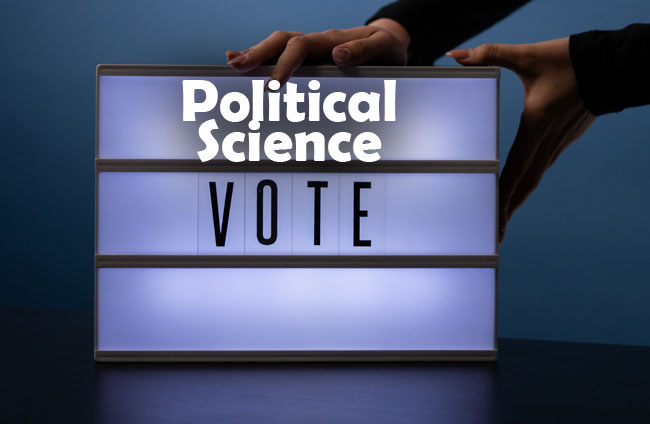Political Science Quiz
Latest Political Science Quiz are available here. So, the candidates who are searching can refer the Political Science Quiz for better preparation. View the free download links of Political Science Quiz Objective Previous Papers in the below section.

Political Science Objective Quiz are available here to download for free. Aspirants can download Political Science Quiz Solved Papers from our website. We have updated the Political Science Quiz Questions which helps the candidates who are appearing for the competitive exam.
Quiz on Political Science
1. Which of the following pairs is not correct?
(A) J. S. Mill — Modern Liberalism
(B) Aristotle — New Liberalism
(C) John Rawls — Theory of Justice
(D) Mao Zedong — Socialist or Class War Stage
2. Which of the following pairs is not correct?
(A) Hegel — Idea of Spirit
(B) Plato — Ideas or Forms
(C) Machiavelli — Modern Constitutionalism
(D) Mao — Real Will
3. Rawls’ principle of distributive justice is based on the notion of:
(A) Desertion
(B) Difference principle
(C) Equality
(D) Entitlement
4. The idea of social contract has been recently revived under a new form by:
(A) Gramsci
(B) Rawls
(C) Oakshott
(D) Hannah Arendt
5. Who among the following favoured qualification as the basis for right to vote?
(A) J. Bentham
(B) J. S. Mill
(C) T. H. Green
(D) E. Barker
6. The theory of social contract primarily seeks …………. .
(A) to explore the historical origin of the state
(B) to explain the basis of political obligation
(C) to justify the status quo
(D) to bring out a radical transformation of society by revolution
7. Who said, ‘the minimal state is the most extensive state that can be justified, any state more extensive violates peoples rights’?
(A) Robert Nozick
(B) Hayek
(C) Michael Sandel
(D) John Rawls
8. The idea of social contract has been recently revived under a new form by:
(A) Nozick
(B) Rawls
(C) Oakshott
(D) Gramsci
9. Find the incorrect statement:
(A) Sri Aurobindo was a revolutionary leader
(B) Mahatma Gandhi’s Satyagraha was meant also for heart transformation of the opponent
(C) Periyar promoted rationalism, self-respect and women’s rights
(D) V.D. Savarkar was the champion of composite nationalism
10. Who believed that the aggregate of the four, body, mind, heart and soul is the individual?
(A) B. G. Tilak
(B) Rabindranath Tagore
(C) Deendayal Upadhyaya
(D) M. N. Roy
11. According to Deendayal Upadhyaya which are four elements of nation?
(A) People who treat their country as mother, Common History, Common Language, Dharma
(B) Desire to live together, Motherland, Common heritage, Common language
(C) People who treat their country as mother, Desire to live together, Dharma, Ideal and Values of life
(D) Desire to live together, Common language, Common History, Dharma
12. Who wrote the book ‘The High Caste Hindu Women’?
(A) Periyar
(B) Pandita Ramabai
(C) B. G. Tilak
(D) M. K. Gandhi
13. Why did Pandita Ramabai founded Arya Mahila Samaj?
(A) To ameliorate the downtrodden women
(B) To give assistance to the widows
(C) To prevent child marriages
(D) To promote women’s education and deliverance from the oppression of child marriage
14. Aurobindo’s ideas of revolution were based on certain philosophical and spiritual foundations such as:
(a) Sachchidananda or the supreme reality
(b) Supermind or truth consciousness
(c) Evolution as means of liberating consciousness
(d) Autonomous mind
Codes:
(A) (a), (c) and (d)
(B) (b) and (c)
(C) (a) and (d)
(D) (a), (b) and (c)
15. Mohammed Iqbal’s ideas can be summarized as:
(a) Quest for idealized theocratic but modern state
(b) Viewing man at the centre of the scheme of things
(c) Believed man to be in charge of dynamism and action
(d) Believed in God’s suzerainty as the provider, the benefactor, the judge, the guide and the beautiful
Codes:
(A) (a), (b) and (c)
(B) (b), (c) and (d)
(C) (c) and (d)
(D) (a) and (d)
16. Who among the following was an early central figure in Vedantic nationalist conceptualization against British rule?
(A) Bankim Chandra
(B) Vivekananda
(C) Dayanand Saraswati
(D) Rabindranath Tagore
17. Which one of the following options was not a part of M. N. Roy’s ‘four classes’ framework in Indian context?
(A) The bourgeoisie
(B) Proletariat
(C) Intellectual
(D) Peasantry
18. Choose the incorrect statement:
(A) Nationalism was the ideological impetus that over the century transformed Europe
(B) Nationalism paved the way to foreign domination
(C) In nationalism nation is viewed with pride and respect
(D) French revolution initiated the movement towards the modern nation-state
19. Who is the author of the book, “Imagined Communities”, in which the issue of nationalism is discussed?
(A) Arnest Gellner
(B) Benedict Anderson
(C) Anthony Smith
(D) Steven Grosby
20. Mozambique was the colony of which imperial power?
(A) Portugal
(B) Spain
(C) Holland
(D) Great Britain
| Test Papers | Model Question |
| Important Question | Previous Papers |
| Practice Set | Quiz |
| Mock Test | GK |
| Sample Question | MCQ |
21. In which of the following states, constitutionalism is absent?
(A) Switzerland
(B) Sweden
(C) Sudan
(D) Sri Lanka
22. Which among the following is not the feature of constitutionalism?
(A) Written constitution
(B) Unlimited rule
(C) Supremacy of constitution
(D) Protection of citizen’s rights
23. Who is associated with the sentence?
‘The will of the people is the product and not the motive power of political process.’
(A) Robert Dahl
(B) Joseph Schumpeter
(C) Steven Lukas
(D) S. M. Lipset
24. Who put forth the concept of ‘Circulation of Elite’?
(A) Robert Mitchels
(B) Wilfredo Pareto
(C) Gaetano Mosca
(D) C. Wright Mills
25. Which among the following is not the feature of majoritarianism?
(A) It is the rule of majority
(B) The rights of minorities are not protected
(C) All citizens of the state cannot participate in the political process
(D) It is an inclusive political system
26. Which is not a device of a direct democracy?
(A) Referendum
(B) Recall
(C) Election
(D) Initiative
27. Which of the following reasons can drive people to seek asylum in another country? Answer using the key below:
(a) Political unrest
(b) Unemployment
(c) Genocide
(d) Displacement due to projects
(A) (a), (b), (c)
(B) (c), (d)
(C) (b), (c), (d)
(D) (a), (c)
28. “Holding the increase in global average temperatures to well below 2 degree celsius above pre-industrial levels, nationally determined targets of decreasing emission levels, focus on climate resilient development.” Which climate change treaty has adopted the above goals?
(A) Paris Agreement
(B) Montreal Protocol
(C) Bali Accord
(D) Kyoto Protocol
29. Richard Snyder is associated with which of the following approach/ theory?
(A) Game Theory
(B) Decision-making Approach
(C) Balance of Power Approach
(D) System Theory
30. Who is the author of the book “Diplomacy of Detente”?
(A) Coral Bell
(B) George Kennan
(C) Henry Kissinger
(D) E. H. Carr
31. The SALT-I treaty was signed by:
(A) France and Soviet Union
(B) Britain and France
(C) France and US
(D) US and Soviet Union
32. When did the UN General Assembly adopt the “Uniting for Peace” Resolution?
(A) During the Vietnam War
(B) During the Korean War
(C) During the Arab-Israel War
(D) During the Falklands War
33. Which of the following groups does not have a free trade agreement among members?
(A) European Union
(B) India-Brazil-South Africa (IBSA)
(C) South Asian Association of Regional Co-operation (SAARC)
(D) Mercosure
34. Who had first proposed the “Atoms for Peace Plan” in 1953?
(A) Richard Nixon
(B) Harry Truman
(C) Dwight Eisenhower
(D) John F. Kennedy
35. Which of the following is the main objective of the Threshold Test Ban Treaty?
(A) Ban on transfer of space technology to the non-nuclear states
(B) Ban on transfer of nuclear technology to non-nuclear states
(C) Ban on nuclear tests having a yield of more than 100 kilotons
(D) Ban on underground nuclear tests having a yield of more than 150 kilotons
36. Assertion (A): India is an emerging power.
Reason (R): India’s economy has grown consistently in the twenty-first century and its influence in the Indo-Pacific region as well as broader international affairs has expanded.
(A) (A) is false, (R) is true
(B) (A) is true, (R) is false
(C) Both (A) and (R) are true, but (R) is not correct explanation of (A)
(D) Both (A) and (R) are true and (R) is the correct explanation of (A)
37. Which of the following statements does not hold true for the Indian Ocean Naval Symposium (IONS)?
(A) It seeks to increase maritime cooperation among navies of the Indian Ocean Region.
(B) It has working group on Humanitarian Assistance and Disaster Relief.
(C) There are thirty-five members of this forum.
(D) US, Russia and China are the members of IONS
38. Which of the following statements is not true?
(A) India has been attending the Shanghai Co-operation Organisation Summits (SCO) as an observer since 2005
(B) India and Pakistan started the process of full membership of SCO in 2015
(C) Pakistan was given full membership of the SCO in 2017
(D) India was denied the membership of the SCO
39. Of which organisations given below is India a member?
(A) Gulf Co-operation Council
(B) Shanghai Co-operation Organisation
(C) Association of Southeast Asian States
(D) European Union
40. Which of the following statements is not true?
(A) The term ‘BRIC’ was coined in 2001 Goldman Sachs Report for the then four emerging economies, Brazil, Russia, India, China
(B) Foreign Ministers of these four countries met for the first time as a group at the margins of UN General Assembly in September 2006
(C) BRICS countries have held annual summits since 2011
(D) South Africa entered the group in 2010
41. Arrange these countries in the descending order of the volume of their trade with India:
(a) Japan
(b) China
(c) US
(d) Russia
(A) (c), (b), (a), (d)
(B) (c), (d), (b), (a)
(C) (b), (c), (d), (a)
(D) (a), (b), (c), (d)
42. Kaladan Multimodal transport project is a part of India’s Look East Policy. Which country is India’s partner in this project?
(A) Myanmar
(B) Bangladesh
(C) Nepal
(D) Bhutan
43. Trilateral Highway Project is a part of India’s Look East Policy. Which two countries are India’s partners in this project?
(A) Bangladesh, Myanmar
(B) Myanmar, Thailand
(C) Bangladesh, Nepal
(D) Myanmar, China
44. Which of the following is not true about the “SAGAR”—an initiative of the India?
(A) It is the acronym of “Security and Growth for all in the region”
(B) It is a clear, high-level articulation of India’s vision for the Indian Ocean
(C) It includes deepening economic co-operation in the region
(D) It promotes Indian Ocean as a zone of peace
45. Which of the following is not a feature of India’s nuclear programme?
(A) Collaboration with US and Canada in the early period
(B) Research on Fast Breeder Reactors
(C) Refusal to sign the Partial Test Ban Treaty
(D) Two nuclear tests, 1974 and 1998
46. 73rd and 74th constitutional amendment deals with:
(A) Panchayati Raj System and Urban Local Self Government
(B) Judicial Review
(C) Federalism
(D) Secularism
47. The following formula in the constitution discusses language issues:
(A) Nehru – Patel formula
(B) Munshi – Iyengar formula
(C) Gandhi – Irwin formula
(D) Ambedkar – Gandhi formula
48. Which of the following is not the feature of Rule of Law?
(A) Supremacy of law
(B) Independent judiciary
(C) Restrictions on the exercise of discretionary power
(D) Dictatorial leadership
49. Eighth schedule of the constitution includes the list of:
(A) Official religions
(B) Castes
(C) Ethnicities
(D) Official languages
50. Who presented the objectives resolution in the Constituent Assembly of India?
(A) Mahatma Gandhi
(B) Sardar Patel
(C) B. R. Ambedkar
(D) Jawaharlal Nehru

